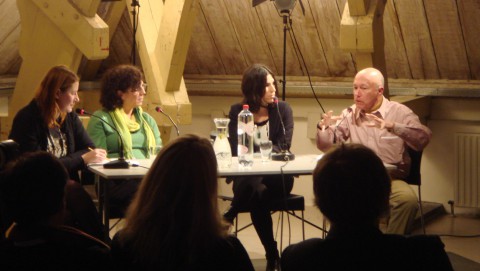Book presentation January 19, Rijksakademie Amsterdam
Report by Madelon van Schie

Book presentation Making Art Global, roundtable discussion with Annie Fletcher, Rachel Weiss, Direlia Lazo and Gerardo Mosquera.
The book presentation of Making Art Global (Part 1): The Third Havana Biennial 1989, with contributions by Rachel Weiss, Luis Camnitzer, Coco Fusco and Geeta Kapur ao, formed part of the program Temporary Stedelijk 3-Stedelijk@Rijksakademie and was organized in collaboration with publisher Afterall Books. Introduced by Annie Fletcher, editor Rachel Weiss and curator Gerardo Mosquera pointed out the groundbreaking aspects of the third Havana Biennial and clarified its context in two presentations and a roundtable discussion in which independent curator Direlia Lazo participated as well.
One of the key aspects of the third Havana Biennial was its break with the curatorial tradition to show segmented national presentations, as has been the practice ever since the establishment of the first Biennial of Venice in 1895. Instead a thematic approach was introduced in the shape of multiple nuclei that each took on aspects related to the Biennial’s focal regions; Latin America, Africa, Asia and the Middle East (the Third World). The second Havana Biennial, held in 1986, had reached the scope of the Third World already; it was the first global contemporary art show. The main reason of the curators to connect with the Third World was to react on prevailing art shows characterized by a one-sided Western vision on contemporary art or, in ‘best’ cases, a centre-periphery relation. The latter had been the essence of the notorious exhibition Magiciens de la Terre that had opened in Paris a few months before the third Havana Biennial. Another important aspect of the third edition was the inclusion of a large international conference, underlining its discursive character. With its meetings, events and publications it wasn’t merely an exhibition. It also functioned as a platform for research, networking, interaction and, as Mosquera put it, a ‘gigantic Salon des Refusés’ in a time in which many artists from the periphery were unknown.
The features of the third edition reveal a shifting direction in curatorial practices. They not only proposed an alternative for the Western patterns of exhibiting art predominantly restricted to an art market related mainstream, but also had the potential to change the circulation –within the Third World- and presentation of international art. According to Mosquera, this Biennial was historic not for its curating but for its curatorial perspective. While the first suffered from the enormous size of the task, that in addition lead into a questionable quality of the selected artworks as Weiss memorized, its curatorial vision pointed towards the internationalization of contemporary art.
In what context could an innovative and progressive art event like the third Havana Biennial arise? Besides the noble goals and pioneering ideas of the curators the government played an important role here. Fidel Castro himself came up with the idea of creating the Havana Biennial. It was a way in which Cuba could publicize itself and build up a good image and, moreover, it enabled the state to contribute to its political aim of becoming a Third World leader. The art event was financially supported by money from the Soviet Union but when the Berlin wall fell – only a few days after the opening of the Biennial- communistic ideals took on a different aspect and the sponsoring stopped. The prosperous times were over and critical artists left the country due to Cuba’s increasingly repressive regime.
Consequently, although the state’s political strategy supported the objectives of the third Biennial, everything changed when we entered the post-Cold War era. Apart from that, the political situation had restricted the Biennial’s global character. After all, European and North American artists were excluded, unless they were migrated Third World citizens. Therefore one can ask to what extend this Biennial actually was global (and wasn’t positively discriminating the normally marginalized artists). Despite the fact that Castro had left the Biennial’s organization to professionals, politics were too much involved in the end. Shortly after the third edition Mosquera resigned. He couldn’t live with the changing policy towards the critical artists he favored while the Biennial became a ‘provider of the international art market’. Mosquera concluded by saying that the Biennial was not independent enough to escape from determinations imposed by the country that created it.
